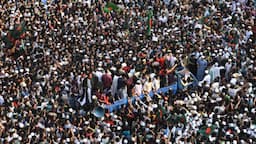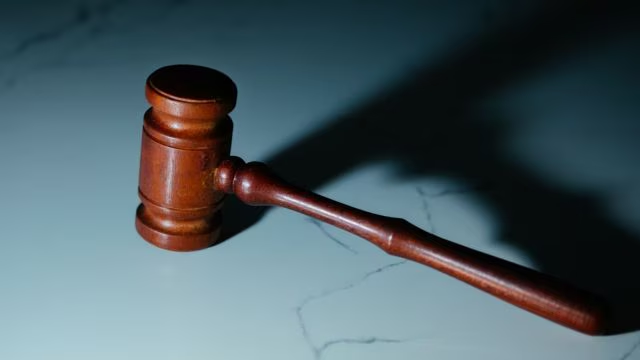The recently released NCERT Class 12 Political Science textbook, which became available in the market last week, avoids mentioning the Babri Masjid by its name and instead refers to it as a "three-domed structure." Additionally, the textbook has condensed the Ayodhya section from four pages to two and has removed significant details from the previous version.
These omissions include the BJP rath yatra from Somnath in Gujarat to Ayodhya, the involvement of kar sevaks, the communal violence that followed the demolition of the Babri Masjid on December 6, 1992, the imposition of President's rule in BJP-ruled states, and the BJP's expression of "regret over the happenings at Ayodhya."

The NCERT had unveiled certain alterations, like the deletion of at least three allusions to the demolition and the significance attributed to the Ram Janmabhoomi movement. Nevertheless, the complete extent of the changes had not been known until now.
Also Read: India’s scientific research on Arctic, Antarctica and Himalayas soon to be part of NCERT textbooks
The fundamental revisions
• The ancient textbook initially presents Babri Masjid as a mosque constructed in the 16th century by Mir Baqi, the General of Mughal emperor Babur. However, the current chapter describes it as a three-dome structure erected in 1528 at the location of Shri Ram's birthplace. Notably, this structure exhibited Hindu symbols and artifacts both inside and outside its premises.
• The mobilization "on both sides" following the unlocking of the masjid in February 1986, as ordered by the Faizabad (now Ayodhya) district court, was extensively described in the old textbook spanning over two pages. It detailed the communal tension, the rath yatra from Somnath to Ayodhya, the kar seva carried out by volunteers in December 1992 to construct the Ram Temple, the demolition of the mosque, and the subsequent communal violence in January 1993. The textbook also made mention of the BJP expressing "regret over the happenings at Ayodhya" and the significant debate surrounding secularism.
• The new version of the textbook now includes a subsection discussing the Supreme Court's ruling on the Ayodhya dispute, titled 'From Legal Proceedings to Amicable Acceptance'. According to this section, conflicts are inevitable in any society, but in a multi-religious and multicultural democratic society, these conflicts are typically resolved through the proper legal channels. The textbook highlights the 5-0 verdict of the Constitutional bench of the Supreme Court on November 9, 2019, which played a significant role in the construction of the temple that was inaugurated in January of this year.
• The verdict allocated the disputed site to the Shri Ram Janmabhoomi Teertha Kshetra Trust for the construction of the Ram temple, while also directing the government to provide an appropriate site for the construction of a Mosque for the Sunni Central Waqf Board. This exemplifies how democracy allows for conflict resolution in a diverse society like ours, upholding the inclusive principles of the Constitution. The resolution of this issue was achieved through the due process of law, considering evidence such as archaeological excavations and historical records. The Supreme Court's decision was widely celebrated by society, serving as a remarkable example of consensus-building on a sensitive matter and demonstrating the maturity of India's democratic values, deeply rooted in our civilization.
• The antiquated textbook displayed images of newspaper cuttings, with one dated December 7, 1992, showcasing the headline "Babri Masjid demolished, Centre sacks Kalyan Govt." Another headline from December 13, 1992, quoted former Prime Minister Atal Bihar Vajpayee stating "Ayodhya BJP's worst miscalculation." All the newspaper clippings have now been erased
• The aged manuscript included an excerpt from the observations made by the then Chief Justice Venkatachaliah and Justice G N Ray of the Supreme Court in the case Mohd. Aslam v. Union of India, dated 24 October 1994, convicting Kalyan Singh, (UP Chief Minister during the demolition) of contempt of court for his failure to "uphold the majesty of law." Furthermore, they stated that "since the contempt raises significant issues that affect the very foundation of the secular fabric of our nation, we also sentence him to a symbolic one-day imprisonment."

Also Read: NCERT Issues Warning Against Copyright Infringement in Educational Materials
This excerpt has now been substituted with a passage from the Supreme Court ruling on November 9, 2019. The ruling emphasizes that every judge in the Court is not only responsible for but also obligated to uphold the Constitution and its principles. The Constitution does not differentiate between the faith and beliefs of different religions. It recognizes that all forms of belief, worship, and prayer are equal. Therefore, it is concluded that the faith and belief of Hindus, both before and after the construction of the Mosque, has consistently been that the birthplace of Lord Ram is the location where the Babri Mosque was built. This faith and belief are supported by both documentary and oral evidence.
This marks the fourth iteration of revising and updating NCERT textbooks since 2014. Regarding the modifications made to the Ayodhya section, the NCERT stated in April that the content has been refreshed to align with the latest political developments. The text pertaining to the Ayodhya issue has undergone extensive revisions in light of the recent changes introduced by the Constitutional bench verdict of the Supreme Court, which has been widely embraced.
















